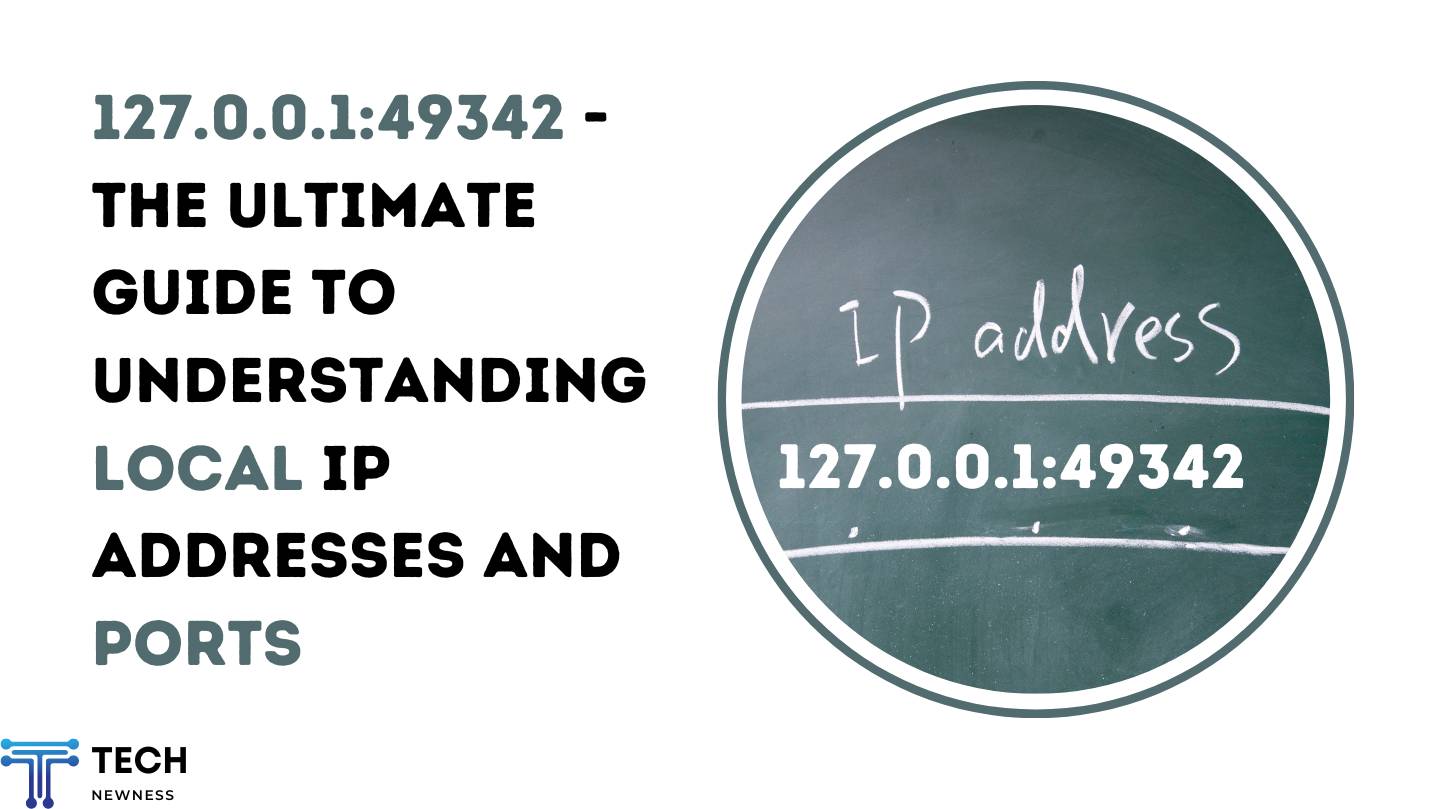Have you ever wondered what 127.0.0.1:49342 means? If you’re a developer or someone diving into the world of networking, understanding local IP addresses and ports is crucial. This article will break down the complexities of 127.0.0.1:49342, making it easy to grasp even for beginners.
Table of Contents
What is an IP Address?
An IP address, or Internet Protocol address, is a unique identifier assigned to devices connected to a network. Think of it as a digital address that allows computers to find and communicate with each other. IP addresses are essential in networking, ensuring that data packets reach the correct destination.
Understanding Ports in Networking
In networking, ports are like doors that allow data to enter or leave a computer. Each port is associated with a specific process or service. When combined with an IP address, ports help direct traffic to the right place within a device. For instance, a web server might use port 80 to handle HTTP requests.
The Significance of 127.0.0.1
127.0.0.1 is a special IP address known as the loopback address. It’s a way for a computer to communicate with itself. When you send a request to 127.0.0.1, it doesn’t go out onto the internet; instead, it stays within your computer, effectively looping back to the source. This is particularly useful for testing and development purposes.
What is 127.0.0.1?
The Concept of Loopback Address
The loopback address is a reserved IP range that includes 127.0.0.1. It’s primarily used for testing and diagnostics. When a computer uses the loopback address, it bypasses the network interface and sends the data directly to itself. This helps in verifying that the TCP/IP stack is working correctly without the need for external network access.
How 127.0.0.1 is Used in Networking
In networking, 127.0.0.1 is used to test network applications and services on the local machine. Developers often use this address to simulate connections and ensure that their software is functioning as expected before deploying it to a live environment.
Common Use Cases of 127.0.0.1
- Testing Web Servers: Developers can run a web server on their local machine and access it via 127.0.0.1.
- Running Local Services: Services like databases or APIs can be run locally and accessed using this address.
- Troubleshooting: Network administrators use 127.0.0.1 to diagnose network-related issues without involving external networks.
Understanding Ports
What are Ports in Networking?
Ports are numerical identifiers in networking that help distinguish between different types of traffic on a network. Each port is associated with a particular service or application. For example, web traffic typically uses port 80 for HTTP and port 443 for HTTPS.
The Role of Port Numbers
Port numbers play a crucial role in ensuring that data reaches the correct application on a device. When a data packet arrives at an IP address, the port number determines which application or service will process that data.
How Ports and IP Addresses Work Together
An IP address identifies the device, while the port number identifies the specific application or service on that device. Together, they form a complete address (e.g., 127.0.0.1:49342) that directs the data to the right destination.
What is Port 49342?
An Overview of Dynamic/Private Ports
Port 49342 falls within the range of dynamic or private ports, which are typically used by applications for temporary communications. These ports are not reserved for any specific service and are often assigned randomly by the operating system.
Specific Uses of Port 49342
While port 49342 doesn’t have a standardized use, it can be assigned to any application or service that needs it. It’s often used in development environments where developers need to assign a unique port for testing purposes.
How Port 49342 Interacts with 127.0.0.1
When combined with 127.0.0.1, port 49342 creates a unique address that directs traffic to a specific application or service running on the local machine. This is useful in development scenarios where multiple services are being tested simultaneously.
The Significance of 127.0.0.1:49342
How IP and Port Combination Works
The combination of 127.0.0.1 and port 49342 creates a unique endpoint that can be used to direct traffic within a computer. This combination allows developers to run multiple services on the same machine without interference, as each service can be assigned a different port.
Common Scenarios Where 127.0.0.1:49342 is Used
- Localhost Testing: Developers often use 127.0.0.1:49342 to test applications locally before deploying them to a live environment.
- Service Isolation: Running multiple services on different ports helps isolate them from each other, preventing conflicts.
- Troubleshooting Network Issues: By using 127.0.0.1:49342, network administrators can diagnose issues within the local machine without affecting the network.
Security Considerations
While 127.0.0.1 is generally safe since it doesn’t expose services to the external network, it’s still important to secure the services running on it. Misconfigurations can lead to potential vulnerabilities if the service is inadvertently exposed to external access.
Why You Might Encounter 127.0.0.1:49342
Localhost Testing
If you’re a developer, you’ll likely encounter 127.0.0.1:49342 during localhost testing. This address is used to test web servers, APIs, and other services on your local machine without exposing them to the internet.
Software Development Scenarios
During software development, you may need to assign a specific port like 49342 to a service for testing purposes. This helps in isolating services and ensuring they function correctly before they are deployed.
Troubleshooting Network Issues
Network administrators use 127.0.0.1:49342 to troubleshoot network issues by isolating the problem to the local machine. This helps in identifying whether the issue lies within the machine itself or the broader network.
How to Access 127.0.0.1:49342
Steps to Access 127.0.0.1:49342
- Open a Web Browser or Command Line: Depending on the service running on port 49342, you can access it via a web browser or command line tool.
- Enter the Address: Type
http://127.0.0.1:49342in the browser’s address bar or use a command likecurlin the terminal. - Access the Service: If the service is running, you’ll see the response in your browser or terminal.
Tools and Commands to Use
- Web Browsers: For web-based services, simply enter
http://127.0.0.1:49342. - Curl Command: Use
curl http://127.0.0.1:49342in the terminal to interact with the service directly. - Telnet or Netcat: These tools can be used to test the connection to port 49342.
What to Expect When Accessing This Address
If a service is running on 127.0.0.1:49342, you’ll receive a response. If not, you may encounter an error like “Connection Refused,” indicating that the port is not in use.
Potential Errors and Issues
Common Errors When Using 127.0.0.1:49342
- Connection Refused: This error occurs if no service is listening on port 49342.
- Port Already in Use: If another application is using port 49342, you may encounter conflicts.
- Firewall Blocking: A firewall may block access to port 49342, leading to connection issues.
How to Troubleshoot and Resolve Issues
- Check Service Status: Ensure that the service is running on port 49342.
- Change Port Number: If the port is already in use, consider changing it to a different number.
- Adjust Firewall Settings: Modify firewall rules to allow traffic to and from port 49342.
Security Implications of Using 127.0.0.1:49342
Why Security is Important
Even though 127.0.0.1 is a loopback address, security is still a priority. Misconfigurations or vulnerabilities in services running on 127.0.0.1:49342 can expose your system to potential threats.
Best Practices for Securing Localhost Connections
- Limit Access: Ensure that services running on 127.0.0.1:49342 are not accessible from external networks.
- Use Strong Authentication: Implement strong authentication methods for services running on localhost.
- Regularly Update Software: Keep your software and services updated to prevent vulnerabilities.
How to Ensure Safe Use of 127.0.0.1:49342
- Monitor Access Logs: Regularly check logs for any suspicious activity.
- Restrict External Access: Use firewall rules to ensure that only local traffic can access 127.0.0.1:49342.
- Use Secure Protocols: Whenever possible, use secure protocols (e.g., HTTPS) to protect data in transit.
How 127.0.0.1:49342 is Used in Different Systems
Use in Windows
In Windows, 127.0.0.1:49342 can be accessed via the command prompt or PowerShell. Developers often use this address for testing web applications and APIs.
Use in macOS
On macOS, you can access 127.0.0.1:49342 using the Terminal. It’s commonly used for testing services like Apache or Nginx.
Use in Linux
Linux users often interact with 127.0.0.1:49342 through the terminal or by editing configuration files for services like Apache, Nginx, or Docker.
Advanced Uses of 127.0.0.1:49342
Integrating with Development Tools
127.0.0.1:49342 can be integrated with various development tools for debugging and testing purposes. Tools like Postman, cURL, and Docker make it easier to work with localhost addresses.
Setting Up Custom Applications
You can assign 127.0.0.1:49342 to custom applications that require a unique port. This is particularly useful in complex development environments where multiple services need to run simultaneously.
Advanced Configuration Options
Advanced users can modify configuration files to change the port number or assign multiple services to different ports on 127.0.0.1. This allows for greater flexibility in testing and development.
Common Misconceptions About 127.0.0.1:49342
Myths vs. Reality
- Myth: 127.0.0.1 is only for advanced users.
- Reality: It’s a fundamental concept used by both beginners and experts.
- Myth: 127.0.0.1 can be accessed from external networks.
- Reality: It’s strictly local and cannot be accessed externally.
Clarifying Common Confusions
Many users confuse 127.0.0.1 with external IP addresses, leading to misconceptions about its usage. It’s essential to understand that 127.0.0.1 is confined to the local machine.
FAQs
What is the Purpose of 127.0.0.1?
127.0.0.1 is used to allow a computer to communicate with itself. It’s commonly used for testing and troubleshooting network applications.
Can 127.0.0.1:49342 Be Accessed from Another Network?
No, 127.0.0.1 is a loopback address and cannot be accessed from external networks. It’s limited to the local machine.
What Happens if Port 49342 is Blocked?
If port 49342 is blocked, the service assigned to it will not function correctly. You may need to unblock the port or assign a different port number.
Is 127.0.0.1:49342 Safe to Use?
Yes, 127.0.0.1:49342 is safe to use, especially for testing and development purposes. However, it’s important to follow best practices for securing localhost connections.
How Do I Change the Port Number?
You can change the port number by modifying the configuration file of the service or application you are running. Ensure that the new port is not already in use.
Conclusion
Understanding 127.0.0.1:49342 is crucial for anyone involved in networking, software development, or IT troubleshooting. This unique combination of IP address and port number allows for efficient local testing and development without exposing services to external networks. By following best practices and securing your localhost connections, you can ensure that 127.0.0.1:49342 remains a valuable tool in your technical toolkit.
See Also: Ultimate Guide to 127.0.0.1:62893 Errors, And Solutions





